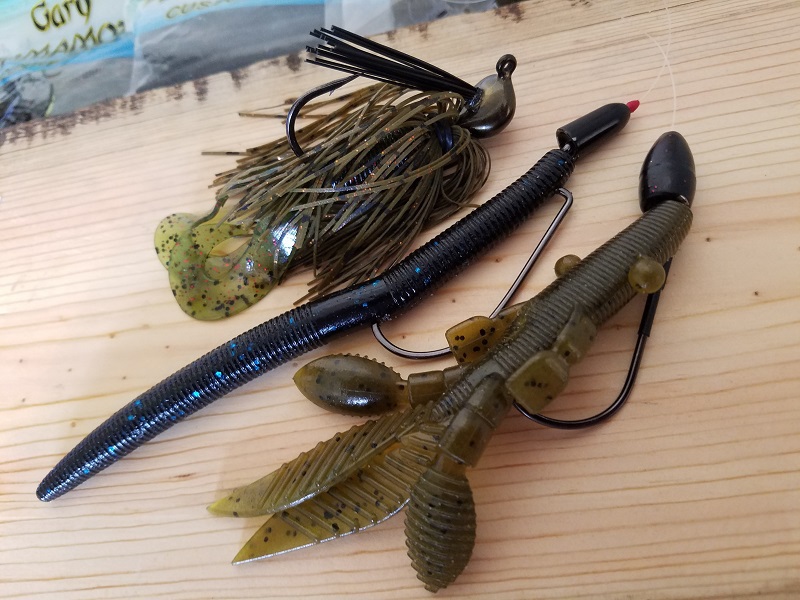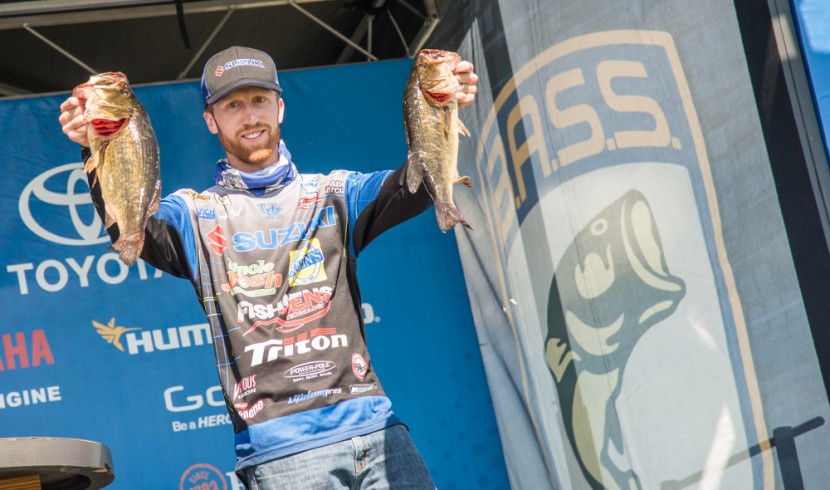
Pitching shallow cover is one of the most exciting ways to catch a bass. Having a bass on your line that close to the boat in a battle is thrilling and is one of the best ways to catch a giant. Bassmaster Elite Series pro Brandon Card uses these techniques as much as he can and has learned over the years that it can be done all year long. In this article he shares some tips for success in all seasons.
When to Pitch a Jig vs. Soft Plastics for Bass
One of the biggest questions among anglers is when to pitch a jig and when to go with a soft plastic. There is no right answer to that question; but Card says, he bases it on water temperature.
“When the water is cold and below 60 degrees, I will most likely be using a jig just because it has a slower fall and bulkier appearance,” he explained. “When the water is warmer and the fish are more active, the soft plastic with more action is usually my first choice.”
Jig Setup for Pitchin' for Bass

Card will use a 3/8- or ½-oz jig the majority of the time. He will use the ½-oz when the water is generally between 50 and 60-degrees and will downsize to the 3/8 when colder. His reasoning is to get a slower fall.
“I like the slower fall and I will also use a jig with a bulkier skirt to slow it down even more if the water is less than say 50 degrees,” he added. “I almost always use a 5-inch Yamamoto Double Tail as my trailer and match the color to my skirt.”
Card fishes this with a 7’6, heavy Abu Garcia Veracity paired with a Revo Rocket reel and spooled with 20-lb Berkley Trilene 100% fluorocarbon.
Soft Plastic Setup for Pitchin' for Bass
Two of Brandon Card’s favorite soft plastics for pitching are the Yamamoto Flappin’ Hog and the tried and true Yamamoto Senko.
Full Yamamoto Catalog Here
“I like the Flappin’ Hog for grass, wood and thick bushes and the Senko anytime I am fishing right before, during and right after the spawn,” he shared.
He uses a variety of different colors but has found that Yamamoto color #297 Green Pumpkin with Large Black Flake works as good as anything in clear water and #021 Black with Large Blue Flake or #388 Dirty Plum for dirtier water.
Card rigs his Flappin’ Hog on a 4/0 Gamakatsu Heavy Cover hook and variety of different sizes of tungsten weights. “I’ll use anywhere from a 5/16- (for sparse cover) to a 1 ½-oz (if I am punching),” he said. “It just depends on how thick the cover is and I will switch the weight often to make sure I have it right.”
For the Senko, Card most often uses a 5-inch version; but will upsize to the 6-inch when fishing a big fish body of water. “Normally, I like to pitch it weightless; but a 3/16-oz weight works well for getting into cover and doesn’t mess up the great action of the bait,” he said.
Card rigs it on a Gamakatsu Round bend worm hook in either 4/0 or 5/0, depending on the size of the Senko.
His rod and reel setup is identical to what he uses for pitching jigs, but will downsize to a 7’6”, MH Abu Garcia Villain 2.0 and Revo MGX reel with 15-lb test for the weightless Senko.
Pitchin’ for Bass Through the Seasons
Each of the different seasons presents a different approach for fishing of all type and pitching is no different. Card changes his methods based on the time of year and has a general rule for each season.
Photo: B.A.S.S.
 Spring Pitchin' For Bass
Spring Pitchin' For Bass
Spring is a time for renewal and new growth and this is exactly what Card is looking for when he is on the water. “I look for the greenest grass and fish the edges of this grass as well as all of the newly flooded cover if the water has come up,” he said.
When fishing wood and other cover, he will focus on the water that is 5-ft deep or less.
Read Related: Technology to Maximize Springtime Bassin' Success with Brandon Card
Summer Pitchin' For Bass
Summer is a time when Card turns his focus to vegetation. “Pads and mats are my first choice, just because of how much shade they provide,” he said.
He will also stay shallow and fish any bushes and cover that still have enough depth to them as many bass will remain shallow long after they spawn.
Fall Pitchin' For Bass
Since many lakes begin to lower in the fall, finding anything cover left is often the only viable choice. “Those logs and laydowns closer to the main lake normally have water around them even when the backs of creeks and pockets are out of water,” he said. “I’ll look for those and also the grass mats if I can find them.”
Winter Pitchin' For Bass
“Unless you are in Florida, the grass is most likely going to be all dead, but whatever is still lingering or even dead grass that is matted will hold fish,” said Card.
He will focus on remaining grass, keying on the clumps and mats and either pitch the edges or punch the mats. When it comes to logs and laydowns, he will fish the deepest points of these as he has found that fish still relate to them, but just position themselves closer to deep water.
Pitching is a great way to get into the biggest bass in the water you are fishing. It is a technique that has proven itself time and time again and Brandon Card says that it can be done anytime the bass are shallow if you focus on the high percentage areas.


 Advertising
Advertising